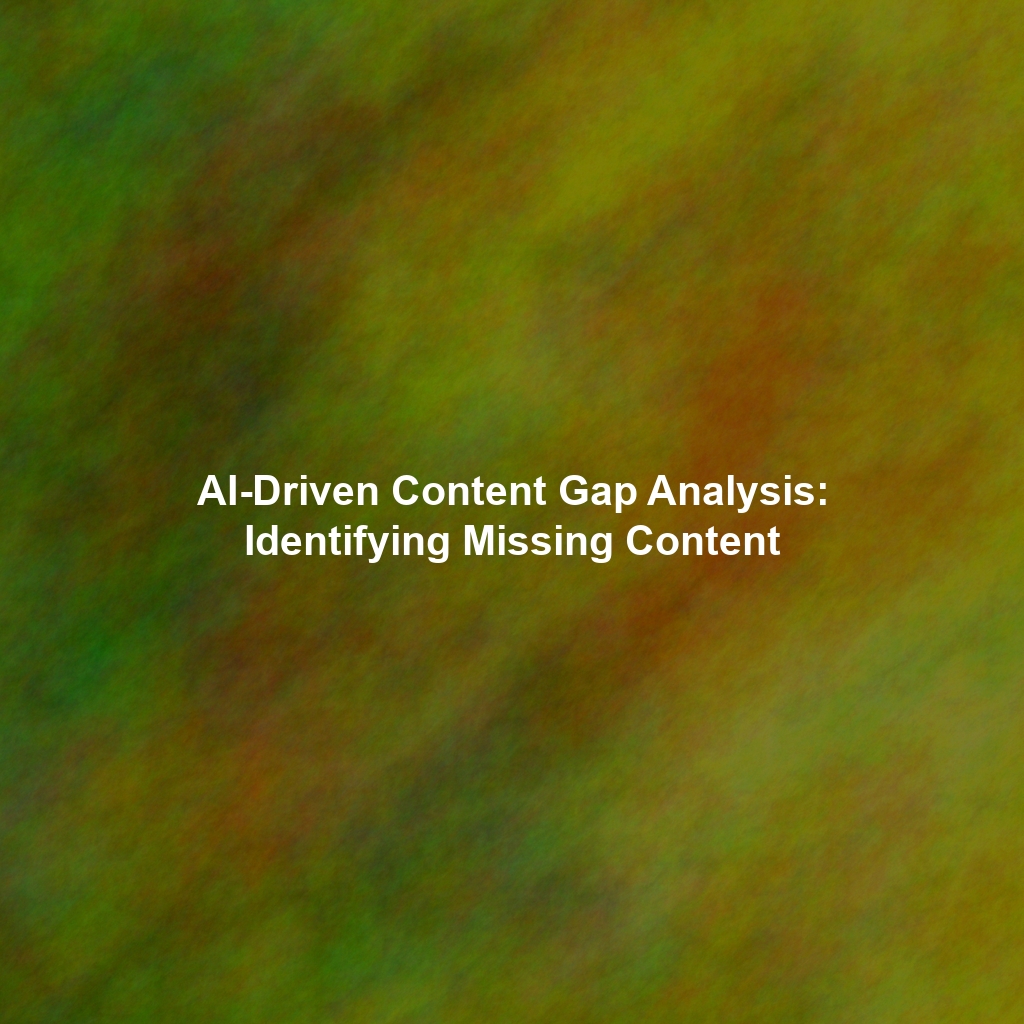Why Audience Understanding is Crucial for Content Marketing
Before diving into the “how,” let’s reinforce the “why.” Understanding your audience directly impacts your ability to:
- Create Relevant Content: Knowing what your audience cares about allows you to tailor your topics, tone, and format for maximum engagement.
- Increase Engagement: Relevant content grabs attention and keeps your audience coming back for more.
- Improve Conversion Rates: Content that addresses specific audience needs and pain points is more likely to drive conversions, whether it’s signing up for a newsletter, requesting a demo, or making a purchase.
- Build Brand Loyalty: By demonstrating that you understand and value your audience, you foster a sense of connection and build lasting relationships.
- Optimize Marketing ROI: Targeting your efforts based on data-driven insights ensures you’re not wasting resources on content that misses the mark.
AI empowers you to move beyond superficial audience profiles and uncover the nuances that truly matter. It helps you identify hidden patterns, predict future behavior, and personalize content at scale.
AI Tools and Techniques for Audience Analysis
Several AI-powered tools and techniques can revolutionize your audience understanding. Here’s a breakdown of some of the most effective:
1. Natural Language Processing (NLP) for Sentiment Analysis
NLP is a branch of AI that focuses on enabling computers to understand and process human language. Sentiment analysis, a key application of NLP, allows you to gauge the emotional tone of text. This is incredibly valuable for understanding how your audience feels about your brand, your content, and your competitors.
How to use it:
- Monitor Social Media: Track mentions of your brand and analyze the sentiment expressed in those mentions. Are people praising your latest product launch? Are they frustrated with your customer service?
- Analyze Customer Reviews: Scour online reviews (e.g., Amazon, Yelp, Google Reviews) and identify recurring themes and sentiments. What are customers consistently praising? What are their common complaints?
- Assess Blog Comments: Analyze the comments on your blog posts to understand how your audience is responding to your content. Are they engaged? Are they disagreeing with your points?
- Evaluate Survey Responses: NLP can help you analyze open-ended survey questions more efficiently, extracting key themes and sentiments from textual responses.
Example: Imagine your company launches a new mobile app. By using NLP to analyze app store reviews, you might discover that users love the app’s intuitive interface but are frustrated with its battery consumption. This insight allows you to prioritize addressing the battery issue in the next update.
2. Machine Learning (ML) for Predictive Analysis
Machine learning algorithms can analyze vast datasets to identify patterns and predict future behavior. In the context of audience analysis, this can be used to forecast content preferences, predict churn, and personalize the customer journey.
How to use it:
- Content Recommendation Engines: ML can power content recommendation engines that suggest relevant articles, videos, or products based on a user’s past behavior and preferences.
- Churn Prediction: Identify customers who are at risk of churning (i.e., unsubscribing or stopping using your product) based on their engagement patterns. This allows you to proactively intervene with personalized offers or support.
- Lead Scoring: Prioritize leads based on their likelihood of converting into paying customers. ML can analyze factors like website activity, email engagement, and demographics to assign a score to each lead.
- Personalized Email Marketing: Tailor email content based on individual subscriber preferences and behaviors. ML can help you identify the types of emails that each subscriber is most likely to open and engage with.
Example: An e-commerce company could use ML to predict which customers are most likely to purchase a particular product. Based on this prediction, they could send personalized email campaigns featuring that product to those specific customers, increasing the likelihood of a sale.
3. AI-Powered Social Listening Tools
Social listening tools go beyond simply monitoring brand mentions. They use AI to analyze conversations across social media platforms, blogs, forums, and other online sources, providing a comprehensive understanding of what people are saying about your industry, your competitors, and your audience’s interests.
How to use it:
- Identify Trending Topics: Discover what topics are currently capturing your audience’s attention. This allows you to create timely and relevant content that taps into those trends.
- Understand Audience Demographics and Interests: Gain deeper insights into your audience’s demographics, interests, and online behaviors.
- Monitor Competitor Activity: Track what your competitors are doing and how their audience is responding. This can help you identify opportunities to differentiate yourself and improve your own strategy.
- Identify Influencers: Discover influential voices in your industry who can help you reach a wider audience.
Example: A clothing retailer could use social listening to identify that its target audience is increasingly interested in sustainable fashion. This insight could lead them to create content highlighting the eco-friendly aspects of their products and partnering with influencers who promote sustainable living.
4. AI-Driven Content Optimization Platforms
These platforms use AI to analyze your existing content and identify areas for improvement. They can provide insights into keyword optimization, readability, tone of voice, and overall content effectiveness.
How to use it:
- Improve SEO: Identify relevant keywords that your audience is searching for and optimize your content to rank higher in search results.
- Enhance Readability: Ensure that your content is easy to understand and engaging for your target audience.
- Optimize Tone of Voice: Adjust the tone of voice of your content to resonate with your audience’s preferences.
- Personalize Content Experiences: Tailor the content experience to individual users based on their preferences and behavior.
Example: A software company could use an AI-driven content optimization platform to analyze its blog posts and identify areas where the language is too technical for its target audience. The platform could then suggest simpler language and more relatable examples to improve readability and engagement.
Putting AI Insights into Action: Content Personalization
The ultimate goal of using AI to understand your audience is to create more personalized content experiences. Content personalization involves tailoring your content to individual users based on their specific needs, preferences, and behaviors.
Here are some ways to personalize your content using AI-driven insights:
- Personalized Website Experiences: Display different content on your website based on a user’s location, browsing history, or previous interactions with your brand.
- Personalized Email Campaigns: Send targeted email campaigns based on a subscriber’s interests, purchase history, or engagement with previous emails.
- Personalized Product Recommendations: Suggest products that are relevant to a user’s past purchases or browsing history.
- Personalized Content Recommendations: Recommend articles, videos, or other content that aligns with a user’s interests and preferences.
- Dynamic Content: Use AI to dynamically adjust the content of your website or emails based on real-time data, such as the user’s location or the current weather.
Example: A travel company could personalize its website by displaying different travel destinations to users based on their past travel history and expressed interests. A user who has previously booked trips to tropical destinations might see recommendations for other tropical getaways, while a user who has booked ski trips might see recommendations for ski resorts.
Ethical Considerations When Using AI for Audience Analysis
While AI offers immense potential for understanding your audience, it’s crucial to use these tools responsibly and ethically. Here are some key considerations:
- Data Privacy: Ensure that you are collecting and using data in a way that complies with privacy regulations (e.g., GDPR, CCPA). Be transparent with your audience about how you are collecting and using their data.
- Bias: Be aware that AI algorithms can be biased based on the data they are trained on. Take steps to mitigate bias in your AI models to ensure that you are not unfairly targeting or excluding certain groups of people.
- Transparency: Be transparent with your audience about how you are using AI to personalize their experiences. Let them know that they have the option to opt out of personalization.
- Security: Protect your audience’s data from unauthorized access and misuse. Implement robust security measures to safeguard sensitive information.
By adhering to ethical principles, you can build trust with your audience and ensure that your use of AI is beneficial for both your business and your customers.
Conclusion: Embrace AI for Deeper Audience Connection
AI is no longer a futuristic fantasy; it’s a present-day reality that can transform your content marketing strategy. By embracing AI tools and techniques for audience analysis, you can gain a deeper understanding of your audience’s needs, preferences, and behaviors. This understanding allows you to create more relevant, engaging, and personalized content experiences that drive results and build lasting relationships. As you integrate AI into your content marketing efforts, remember to prioritize ethical considerations and data privacy to build trust and maintain a positive relationship with your audience. The future of content marketing is intelligent, personalized, and deeply connected to the audience it serves.
 Skip to content
Skip to content

